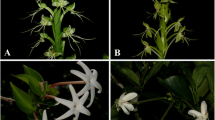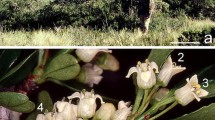Summary
Although the importance of pollinators has most often been examined in the evolution of floral characters, seed predators may also play a role in shaping floral evolution. In this study, I examined the role of interplant distance, plant size, and flower morphology on Ipomopsis aggregatás (Polemoniaceae) attractiveness to a pre-dispersal seed predator, Hylemya sp. (Anthomyiidae) and to hummingbird pollinators. The attractiveness of I. aggregata individuals to Hylemya was nonlinearly related to interplant distance in experimental arrays. Clumped and highly dispersed plants were preyed upon more frequently than those at intermediate distances. I found no relationship between interplant distance and visitation rates by hummingbird pollinators in these experimental arrays. However, in natural populations studied, clumped plants were more frequently approached by hummingbirds than those growing more widely dispersed. Display size was unrelated to visitation by Hylemya on inflorescences I clipped and maintained as “large”, “small” and “control”. Display size was also unrelated to the total number of visits by hummingbird pollinators to each of these experimental plants, however “large” display plants were more likely to be visited first in any given visitation sequence. Of various morphological measurements, corolla length showed the strongest positive correlation with Hylemya egg presence. To the extent that plant spacing and morphology is correlated with pollinator visits and ultimate seed set, Hylemya could be choosing flowers optimally, and playing a role in the evolution of floral traits.
Similar content being viewed by others
References
Augsburger CK (1980) Mass-flowering of a tropical shrub (Hybanthus prunifolius): influence on pollinator attraction and movement. Evolution 34:475–488
Augsburger CK (1981) Reproductive synchrony of a tropical shrub: experimental studies on effects of pollinators and seed predators on Hybanthus prunifolius (Violaceae). Ecology 62:775–788
Bach CE (1980) Effect of plant diversity and time of colonization on an herbivore-plant interaction. Oecologia 44:319–326
Beattie AJ, Breedlove DE, Ehrlich PR (1973) The ecology of the pollinators and predators of Frasera speciosa. Ecology 54:81–91
Bergelson J, Karieva P (1987) Barriers to movement and the response of herbivores to alternative cropping patterns. Oecologia 71:457–460
Brody AK (1991) Pre-dispersal seed predation by Hylemya (Delia) sp. (Diptera: Anthomyiidae): Mechanisms and consequences of oviposition choice. PhD dissertation Univ of California, Davis
Campbell DR (1989a) Inflorescence size: test of the male function hypothesis. Am J Bot 76:730–738
Campbell DR (1989b) Measurements of selection in a hermaphroditic plant: variation in male and female pollination success. Evolution 43:318–334
Campbell DR (1991) Effects of floral traits on sequential components of fitness in Ipomopsis aggregata. Am Nat 137:713–737
Campbell DR, Waser NM (1989) Variation in pollen flow within and among populations of Ipomopsis aggregata. Evolution 43:1444–1455
De Steven D (1983) Reproductive consequences of insect seed predation in Hamamelis virginiana. Ecology 64:89–98
Elam DR, Linhart YB (1988) Pollination and seed production in Ipomopsis aggregata: differences among and within flower color morphs. Am J Bot 75:1262–1274
Evans EW (1983) The influence of neighboring hosts on colonization of prairie milkweeds by a seed-feeding bug. Ecology 64:648–653
Faegri K, van der Pijl L (1971) The principles of pollination ecology, Pergamon Press, New York, 291 pp
Galen C (1989) Measuring pollinator-mediated selection on morphometric floral traits: bumblebees and the alpine sky pilot, Polemonium viscosum. Evolution 43:882–890
Galen C, Stanton ML (1989) Bumble bee pollination and floral morphology: factors influencing pollen dispersal in the alpine sky pilot, Polemonium viscosum (Polemoniaceae). Am J Bot 419–426
Geber MA (1985) The relationship of plant size to self-pollination in Mertensia ciliata. Ecology 66:762–772
Hainsworth FR, Wolf LL, Mercier T (1984) Pollination and predispersal seed predation: net effects on reproduction and inflorescence characteristics in Ipomopsis aggregata. Oecologia 63:405–409
Hainsworth FR, Wolf LL, Mercier T (1985) Pollen limitation in a monocarpic species, Ipomopsis aggregata. J Ecol 73:263–270
Janzen DH (1971a) Seed predation by animals. Ann Rev Ecol Syst 2:465–492
Janzen DH (1971b) Cassia grandis L beans and their escape from predators: A study in tropical predator satiation. Ecology 52:964–979
Jones CE, Little RJ (1983) Handbook of experimental pollination biology, Scientific and Academic Editions, New York 558 pp
Karieva P (1982) Experimental and mathematical analyses of herbivore movement: quantifying the influence of plant spacing and quality on foraging discrimination. Ecol Monog 52:261–282
Karieva P (1983) Influence of vegetation textue on herbiovore populations: resource concentration and herbivore movement. In: Denno RF, McClure MS (eds) Variable plants and herbivores in natural and managed systems, Academic Press, New York, pp 259–289
Karieva P (1985) Finding and losing host plants by fiea beetles: patch size and surrounding habitat. Ecology 66:1809–1816
Molau U, Eriksen B, Knudsen JT (1989) Predispersal seed predation in Bartsia alpina. Oecologia 81:181–185
Moore LR (1978) Seed predation in the Legume Crotalaria II Correlates of interplant variability in predation intensity. Oecologia 34:203–223
Pyke GH (1981) Optimal foraging in hummingbirds: Rule of movement between inflorescences. Anim Behav 29:889–896
Queller DC (1985) Proximate and ultimate causes of low fruit production in Asclepias exaltata. Oikos 44:373–381
Rausher MD, Mackay DA, Singer MC (1981) Pre-and post-alighting host discrimination by Euphydryas editha butterflies: the behavioral mechanisms causing clumped distributions of egg clusters. Anim Behav 29: 1220–1228
Real LA (1983) Pollination biology, Academic Press, New York, pp 338
Root RB (1973) Organization of plant-arthropod association in simple and diverse habitats: the fauna of collard (Brassica oleracea). Ecol Monogr 43:95–120
Schemske DW (1980) Evolution of floral display in the orchid Brassavola nodosa. Evolution 34:489–493
Schmid-Hempel P, Speiser B (1988) Effects of inflorescence size on pollination in Epilobium augustifolium. Oikos 53:98–104
Stanton ML, Preston RE (1988a) Ecological consequences and phenotypic correlates of petal size variation in wild radish, Raphanus sativus (Brassicaceae). Am J Bot 75:528–539
Taylor OR, Inouye DW (1985) Synchrony and periodicity of flowering in Frasera speciosa (Gentianaceae). Ecology 66:521–527
Thomson JD (1988) Effects of variation in inflorescence size and floral rewards on the visitation rates of traplining pollinators of Aralia hispida. Evol Ecol 2:65–76
Waser NM (1978) Competition for hummingbird pollination and sequential flowering in two Colorado wildflowers. Ecology 59:934–944
Waser NM (1983) The adaptive nature of floral traits: ideas and evidence. In: Real LA (ed) Pollination biology, Academic Press, New York pp 241–285
Waser NM, Price MV (1983) Optimal and actual outerossing in plants, and the nature of plant-pollinator interaction. In: Jones CE and RJ Little (eds) Handbook of experimental pollination biology, Van Nostrand Reinhold, New York, pp 241–285
Waser NM, Price MV (1989) Optimal outcrossing in Ipomopsis aggregata: seed set and offspring fitness. Evolution 43:1097–1109
Willson MF, Rathcke BJ (1974) Adaptive design of floral display in Asclepias syriaca L. Am Midl Nat 92:47–57
Willson MF, Miller LJ, Rathcke BJ (1979) Floral display in Phlox and Geranium: adaptive aspects. Evolution 33:52–63
Young HJ, Stanton ML (1990) Influences of floral variation on pollen removal and seed production in wild radish. Ecology 71:536–547
Zimmerman M (1980a) Reproduction in Polemonium: pre-dispersal seed predation. Ecology, 61:502–506
Zimmerman M (1980b) Reproduction in Polemonium: competition for pollinators. Ecology 61:497–501
Zimmerman M (1982) Facultative deposition of ovipositiondetering pheromone by Hylemya. Environ Entomol 11:519–522
Author information
Authors and Affiliations
Rights and permissions
About this article
Cite this article
Brody, A.K. Oviposition choices by a pre-dispersal seed predator (Hylemya sp.). Oecologia 91, 56–62 (1992). https://doi.org/10.1007/BF00317241
Received:
Accepted:
Issue Date:
DOI: https://doi.org/10.1007/BF00317241




